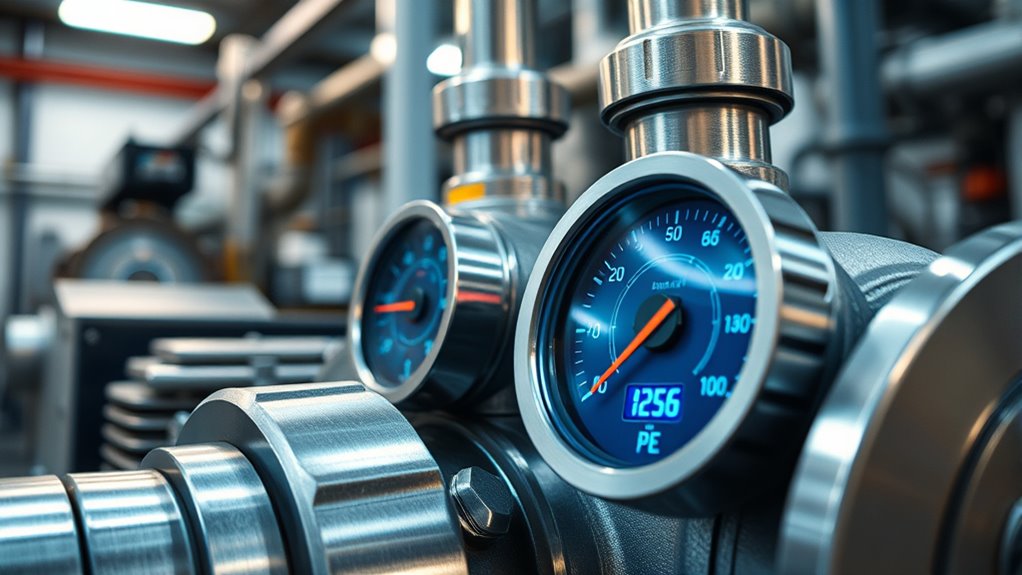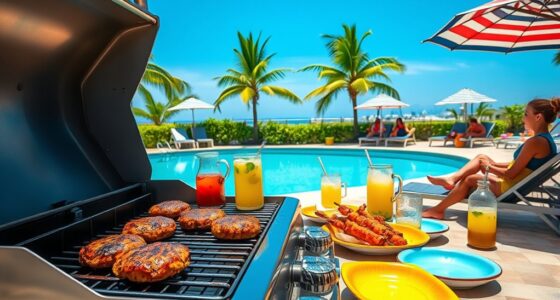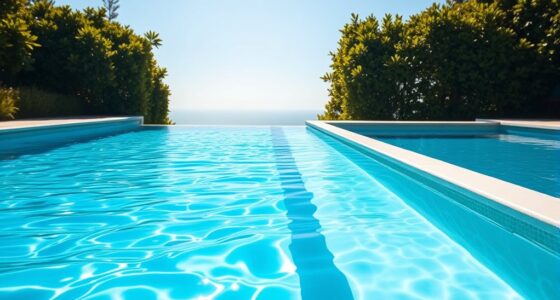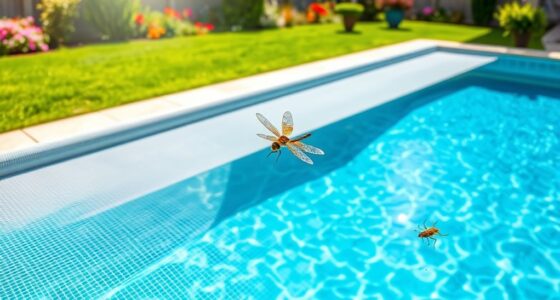To determine how long to run your pool pump, first calculate your pool’s volume and flow rate. Industry standards recommend circulating the entire water volume at least twice daily, meaning you’ll divide the total gallons by the pump’s flow rate. Factors like pool size, usage, and weather affect this time. Running your pump too long or short can impact water quality and energy use—exploring further will help you optimize your system efficiently.
Key Takeaways
- Aim for at least two full turnovers per day for public pools, typically requiring 8-12 hours of pump run time.
- Calculate run time by dividing pool volume by pump flow rate, then convert to hours for proper circulation.
- Larger pools or higher usage may need longer run times, sometimes exceeding 10 hours daily.
- Adjust pump operation based on environmental factors, bather load, and water clarity to optimize efficiency.
- Use variable speed pumps and smart scheduling to maintain proper turnover while reducing energy costs.
Understanding Turnover Rate and Its Significance
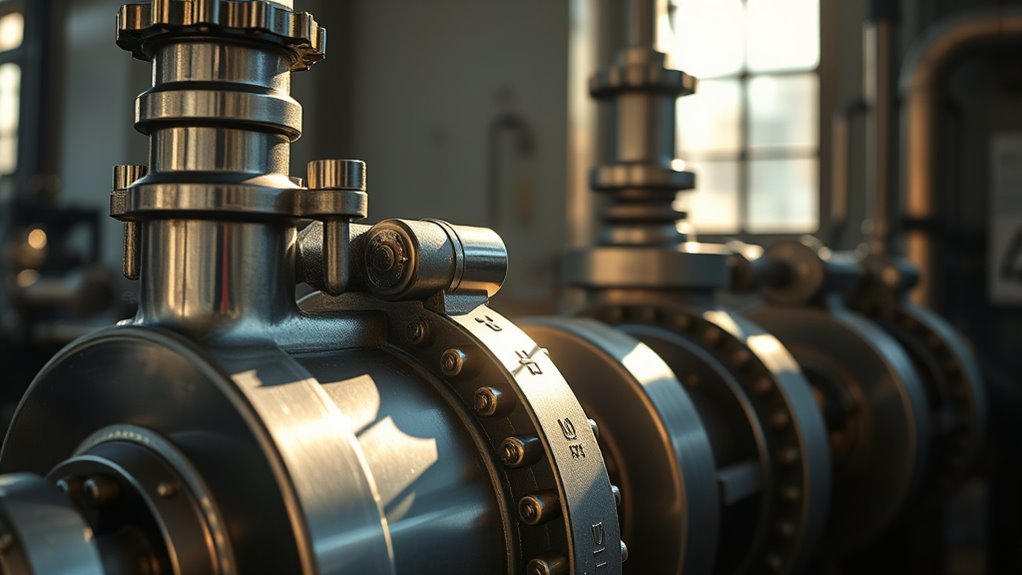
Understanding the turnover rate is essential for maintaining a healthy and safe swimming environment. It measures how long it takes for all the pool water to pass through the circulation system once. You find it by dividing your pool’s volume by the flow rate, usually expressed in gallons per minute. For example, a 20,000-gallon pool with a flow rate of 300 gallons per minute has a turnover time of about 1.11 hours. Proper turnover ensures effective filtration by removing contaminants and preventing algae growth, which keeps water clear and balanced. Industry standards often recommend turning over the entire pool at least twice daily or four times in 24 hours for public pools. Maintaining the correct turnover rate directly supports swimmer health and safety, ensuring the water stays clean and safe. Additionally, understanding the value of security systems can help protect pool facilities and equipment from theft or vandalism.
Calculating Your Pool’s Volume Accurately

Knowing your pool’s exact volume is essential for proper water chemistry management and effective filtration. To determine it accurately, measure the length, width, and average depth—especially for variable-depth pools. Calculate surface area by multiplying length and width, then find volume in cubic feet by multiplying surface area by the average depth. Convert cubic feet to gallons using the appropriate multiplier:
Accurately measure your pool’s dimensions to determine its volume for optimal maintenance.
- For rectangular/square pools: multiply by 7.5
- For round/oval pools: multiply by 5.9
- For irregular shapes: divide into regular sections, calculate each, then sum
- For multi-depth pools: use segmented measurements
- Use online calculators for complex shapes, but manual measurements often yield better accuracy. Measuring water depth accurately is crucial for precise volume calculation. Always measure at the waterline, and remeasure after significant changes for precise calculations. Additionally, understanding your pool’s water volume can help optimize your filtration and chemical dosing schedules.
The Role of Flow Rate in Pool Circulation
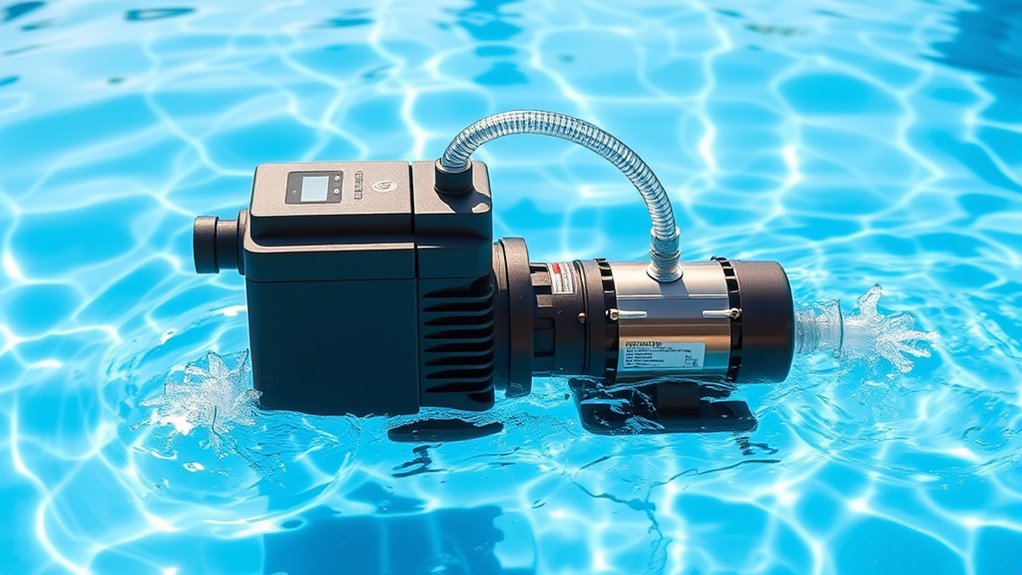
Flow rate plays a crucial role in how effectively your pool water circulates, directly impacting water quality and system efficiency. It represents how fast water moves through your system, measured in GPM, LPM, or m³/hr. Accurate flow rate measurement helps you determine how long it takes for the entire pool volume to pass through the filter, ensuring proper turnover. A higher flow rate improves circulation, promoting even temperature distribution and better chemical dispersion. It also prevents stagnant areas where algae and bacteria can grow. However, too high a flow rate can reduce filtration contact time, destabilizing water chemistry. Balancing flow rate is essential for effective filtration, water clarity, and swimmer comfort, while ensuring the system runs efficiently without excessive energy use. Proper flow management ensures the system maintains optimal filtration contact time, which is essential for effective pool health and safety. Additionally, understanding the regulatory standards related to flow rate can help ensure compliance and optimal system performance.
How to Determine the Right Pump Run Time

To determine the right pump run time, start by calculating your pool’s volume using its dimensions and shape, then use that figure to find the minimum filtration period. Use the appropriate formula: for rectangular pools, multiply length × width × average depth by 7.5; for round pools, diameter squared × average depth by 5.9; for oval pools, length × width × average depth by 6.7; for kidney-shaped pools, widest point squared × length × average depth by 7.5; and for free-form pools, longest length × widest width × average depth by 5.9. Once you have your pool’s volume, divide it by your pump’s flow rate (GPM) multiplied by 60 to find the minimum run time. Proper circulation is essential for preventing clogged filters and maintaining water quality. Adjust based on weather, usage, and water clarity.
Factors That Influence Turnover Time Needs

Several key factors influence how long your pool needs to run to achieve proper water turnover. Your pool’s size and volume directly impact run times; larger pools over 20,000 gallons often need 10+ hours, while smaller ones under 10,000 gallons may require less than 8 hours. Climate and weather conditions also play a role—hotter, sunny, or windy days increase evaporation, debris, and algae, demanding longer filtration. Rainstorms introduce contaminants requiring extended pump hours. Pool usage and bather load matter too; high occupancy or frequent use in public pools calls for shorter turnover times, often under 6 hours. Pool type, design, and equipment efficiency further influence needs. Well-maintained, modern pumps operate more efficiently, reducing required run times, while older or dirty filters prolong circulation requirements. Proper water circulation is essential to maintain water safety, clarity, and chemical balance, which also influences how long your pump should run. Additionally, filtration system efficiency impacts the overall duration needed for effective water turnover.
Recommended Turnover Times for Different Pool Types
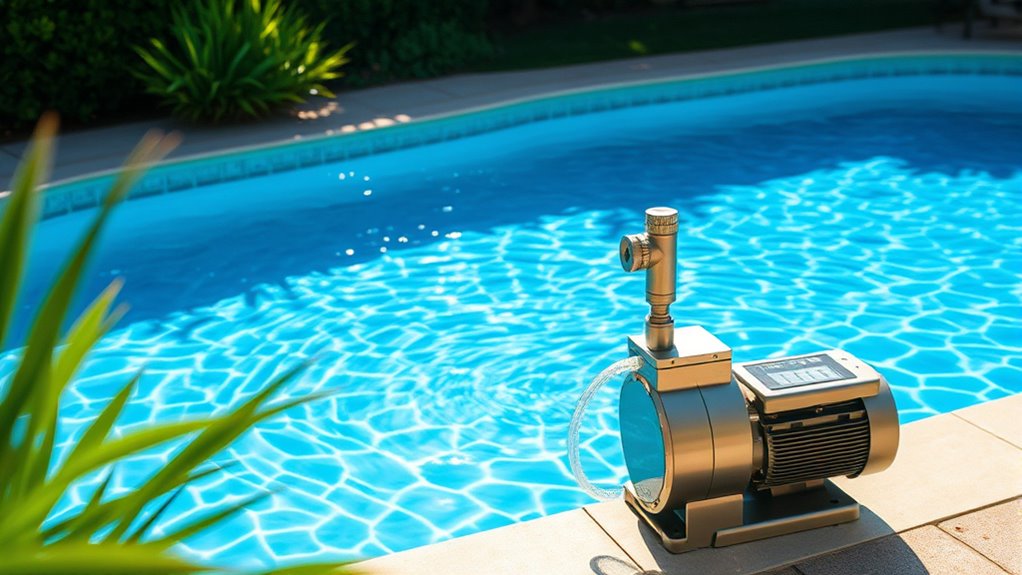
Understanding the recommended turnover times for different pools helps guarantee water quality and safety. Residential pools typically require 8 to 12 hours, while commercial pools often need faster cycles of 6 hours or less. Knowing these standards allows you to select the right equipment and maintain compliance with regulations. Proper circulation ensures chemicals mix and work effectively, further supporting water quality and swimmer health. Additionally, engine tuning can influence the efficiency of your pool pump, indirectly impacting turnover times and energy consumption.
Residential Pool Standards
Residential pool standards recommend a turnover time of roughly 8 to 12 hours to guarantee proper water circulation and filtration. This range ensures your pool stays clean, safe, and well-maintained without excessive energy use. Typically, a turnover rate of 8-10 hours is ideal for most residential pools. Some codes suggest a minimum of 12 hours, ensuring the entire volume passes through the filter daily. Faster turnover rates, under 6 hours, aren’t usually necessary and can increase equipment wear and energy costs without added benefits. To optimize your system, consider these points:
- Use 8-10 hours for standard pools
- Aim for 12 hours if required by local codes
- Adjust for heated or saltwater pools
- Shorten turnover for high bather loads
- Avoid faster rates to conserve energy and prolong equipment life
- Understanding water circulation principles can help maintain water quality more effectively.
Commercial Pool Regulations
When it comes to maintaining water quality in commercial pools, adhering to specific turnover times is indispensable for safety and compliance. Most commercial pools must circulate water within six hours or less, ensuring the entire volume is filtered regularly. Turnover rate is defined as the time needed to move a volume equal to the pool’s maximum capacity, and these requirements are enforced 24/7. Different pool types have specific limits: wading pools, wave pools, and zero-depth entry pools require a maximum of two hours, while diving pools can go up to 12 hours. Competition and general pools should also meet a six-hour turnover, with older pools possibly needing eight hours based on bather load calculations. Vetted regular monitoring of flow rates and system maintenance are crucial to meet these stringent standards and ensure safe, clean water.
Balancing Water Quality and Energy Efficiency

Finding the right balance between water quality and energy use means choosing an ideal turnover duration that keeps your pool clean without wasting power. Adjusting pump schedules and using variable speed pumps can markedly cut energy costs while maintaining effective filtration. By fine-tuning these strategies, you guarantee clean water and lower utility bills at the same time.
Optimal Turnover Duration
Balancing water quality with energy efficiency requires selecting an ideal turnover duration that guarantees clean, safe water without unnecessary energy consumption. The goal is to run your pump long enough to maintain proper circulation, chemical balance, and clarity, but not so long that energy costs skyrocket. Typically, residential pools need about 6 to 10 hours, with 8 hours as a common baseline. Factors like pool size, usage, and environmental conditions influence this timing. To optimize, consider:
- Adjusting run time seasonally or based on usage
- Running multiple shorter cycles daily
- Monitoring flow rate with a pump meter
- Ensuring proper filter capacity
- Avoiding overrun to reduce energy waste
- Understanding the turnover rate helps you set a balanced pump schedule that maintains water quality efficiently.
This approach helps maintain water quality efficiently, balancing health standards with cost considerations.
Energy Consumption Impact
Have you considered how the type of pool pump affects your energy bills? Standard single-speed pumps use around 2000 watts, consuming about 480 kWh monthly during 8-hour daily runs. In contrast, variable speed pumps operate at roughly 300 watts, using only about 72 kWh in the same period. This drastic difference can cut your energy costs considerably. Larger horsepower and older motors draw more power, increasing expenses, while energy-efficient models reduce consumption further. Longer pump operation during hot seasons can raise your energy use, but variable speed pumps allow you to run longer at lower speeds, saving energy without sacrificing water quality. Upgrading to energy-efficient pumps and managing run times smartly helps balance maintaining clean water and lowering electricity bills. Energy-efficient operation can further optimize your pool’s energy use and cost savings.
Pump Scheduling Strategies
Effective pump scheduling requires carefully timing operations to meet water demand without compromising quality or increasing energy costs. Striking this balance involves considering water turnover, tank levels, and equipment wear, while also leveraging advanced strategies. To optimize your system, consider these approaches:
- Shift pumping to off-peak hours using economy pumping, storing water for peak demands.
- Use variable-frequency drives to match pump speed with real-time demand, reducing cycling.
- Implement zone-based setpoints for localized control, maintaining quality in different network areas.
- Automate monitoring to detect overflow events and respond promptly, ensuring safety and quality.
- Integrate with SCADA systems for real-time data collection and dynamic scheduling adjustments.
Research shows that implementing these strategies can significantly improve system efficiency and water quality. These strategies help you maintain high water quality, extend equipment life, and improve energy efficiency simultaneously. Additionally, understanding water turnover can lead to more precise scheduling, helping prevent stagnation and ensuring consistent water freshness.
Using Variable Speed Pumps to Optimize Run Time

Using variable speed pumps allows you to fine-tune the pump’s run time and flow rates, which helps optimize system performance and extend equipment life. By adjusting pump speed through a VFD or variable-torque transmission, you can match flow to actual demand, reducing unnecessary runtime. This control minimizes mechanical stress during start-up and shutdown, thanks to ramp-up and ramp-down sequences. Operating at lower RPMs for longer periods decreases noise, vibration, and wear, prolonging pump lifespan. Additionally, programming specific speed and torque patterns gives you precise control over run schedules, ensuring efficient circulation. By shifting the pump’s duty point along the efficiency curve, you can lower energy consumption and prevent overworking the system, ultimately improving overall reliability and reducing operational costs. Variable displacement hydraulic pumps improve energy efficiency by matching hydraulic fluid flow to system needs, further supporting optimized pump operation. A proper maintenance schedule also plays a crucial role in sustaining optimal pump performance over time.
Monitoring and Maintaining Your Circulation System
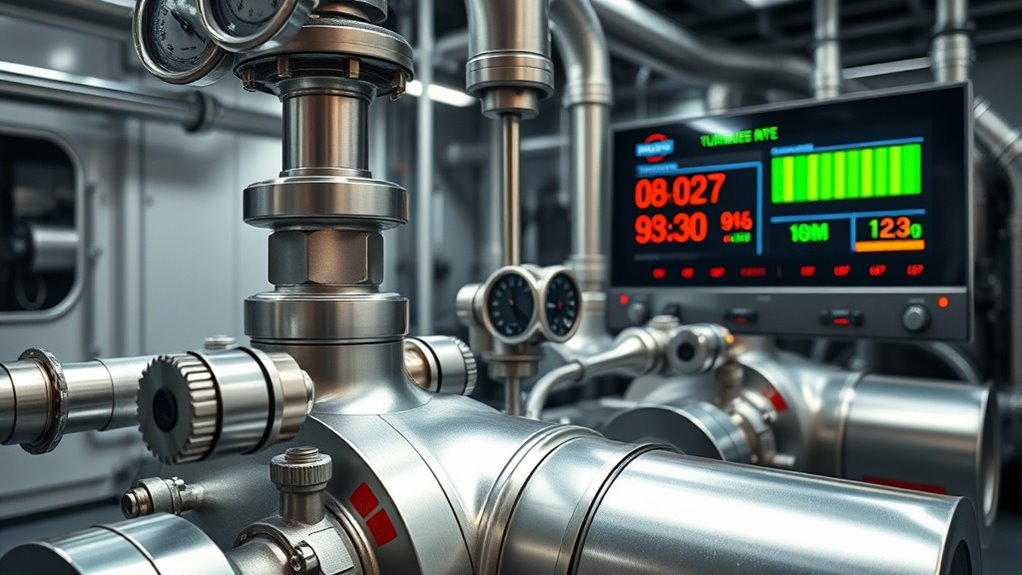
To keep your circulation system running smoothly, you need to perform regular checks and maintenance. Schedule routine inspections, like cleaning filters and testing pump performance, to catch issues early. Proper calibration and timely repairs will help guarantee ideal water flow and extend your equipment’s lifespan. Regularly inspecting the pump’s performance ensures that any signs of wear or inefficiency are identified before they lead to system failure. Additionally, understanding the installation guidelines can help prevent common problems and ensure the system operates safely and efficiently.
Regular System Checks
Regular system checks are essential to guarantee your circulation monitoring remains accurate and reliable. These checks help identify issues early, ensuring timely intervention. During your routine checks, focus on crucial areas such as verifying device function, inspecting electrode placement, and confirming data transmission. Additionally, assess the following:
- Ensure vital sign monitors are functioning every 4 hours or as per ICU standards
- Assess hemodynamic circuits at shift changes and regularly every 4 hours
- Confirm continuous ECG, pulse oximetry, and capnography are operating properly
- Check for data gaps or device disconnections
- Review backup feeds and security features for uninterrupted data flow and protection
- Data accuracy is vital, so regularly calibrate and verify device readings against manual assessments. Maintaining proper calibration ensures consistent measurements and reduces errors in patient monitoring.
Calibration and Maintenance
How can you guarantee your circulation system operates at peak efficiency? Regular calibration and maintenance are key. Start by monitoring pump performance: listen for unusual noises, check temperature differences, and track energy consumption to spot inefficiencies. Keep an eye on water flow rates to detect irregularities. Monitoring flow rates regularly helps detect early signs of system issues to prevent costly repairs and maintain optimal performance. Maintain detailed logs to connect performance with maintenance activities. Always power down the pump before cleaning or lubricating, using soft brushes to remove sediment and lubricating bearings as specified. Schedule monthly inspections for wear, leaks, and cleanliness, and perform quarterly filter maintenance. Adjust pump speed and flow based on demand, and recalibrate sensors regularly to ensure accurate readings. Balance system pressures and remove airlocks to prevent cavitation, ensuring continuous, efficient circulation.
Tips for Adjusting Run Time Based on Conditions

Adjusting your pool’s run time based on current conditions guarantees ideal water quality and energy efficiency. To do this effectively, consider factors like pool size, shape, and capacity. Larger pools or those with irregular shapes need longer run times, especially during peak usage or in windy weather. Pumps with higher flow rates can circulate water faster, reducing needed run time but may waste energy if not scheduled properly. Seasonal changes, such as hotter months or storms, also demand longer filtration periods. Additionally, increased swimmer activity or debris from surrounding vegetation require adjustments. Regular chemical testing helps determine if longer run times are needed to restore balance. Understanding the impact of pool design on filtration needs can help optimize your schedule and save energy. Monitoring vape juice shelf life is essential to ensure your products remain safe and effective, especially when stored improperly or past their expiration.
Frequently Asked Questions
How Often Should I Test My Pool’s Flow Rate?
You should test your pool’s flow rate at least once a month to guarantee proper circulation and water quality. During periods of heavy use or after maintenance, it’s wise to test more frequently. Using a flow meter provides accurate readings, helping you identify issues early. Regular testing keeps your pool compliant with regulations, maintains safe and clean water, and improves energy efficiency, saving you money in the long run.
Can Variable Speed Pumps Reduce Overall Energy Costs?
Yes, variable speed pumps can markedly reduce your overall energy costs. They adjust their speed based on your pool’s needs, consuming up to 70% less energy than traditional pumps. By running at lower speeds during regular filtration and only increasing power when necessary, you save money on electricity bills. Although they have a higher upfront cost, their energy efficiency leads to substantial savings over the pump’s lifespan.
What Are Signs My Turnover Time Is Too Short or Too Long?
If your turnover time is too short, you’ll notice rapid cycling, frequent short runs, temperature swings, and higher energy bills. Conversely, if it’s too long, your system runs continuously, struggles to reach comfort, or your indoor temperature stays inconsistent. Keep an eye out for excessive noise, wear, or inefficiency. Proper cycling involves 2-3 cycles per hour with 10-20 minute runs, ensuring comfort and efficiency.
How Do Weather Changes Affect My Pool’s Required Run Time?
Weather changes can surprise you by forcing your pump to work more or less, depending on conditions. Hot, sunny days speed up algae growth, so you’ll need longer run times—sometimes up to 18 hours. Cooler, cloudy weather slows things down, allowing shorter cycles. Rain, wind, or storms mean extra debris, requiring extended filtration. Keep an eye on the weather, and adjust your pump schedule accordingly to keep your pool pristine.
Are There Safety Risks Associated With Running the Pump Excessively?
Running your pump excessively poses safety risks you should consider. It can cause mechanical wear, leading to potential breakdowns or overheating, which increases fire or burn hazards. Extended operation also stresses electrical systems, raising the risk of fires or shorts. Additionally, prolonged use exposes you to moving parts, increasing injury chances, and can fatigue operators, making accidents more likely. To stay safe, follow recommended run times and perform regular maintenance.
Conclusion
Think of your pool’s circulation as a gentle dance, each beat and step essential to harmony. By understanding your turnover rate and adjusting your pump’s rhythm, you keep the water clear and inviting. Balance energy with efficiency, and let your system flow smoothly. With mindful monitoring and adjustments, you’ll choreograph a perfect dance of clean, healthy water—where every move keeps your pool sparkling and serene.

